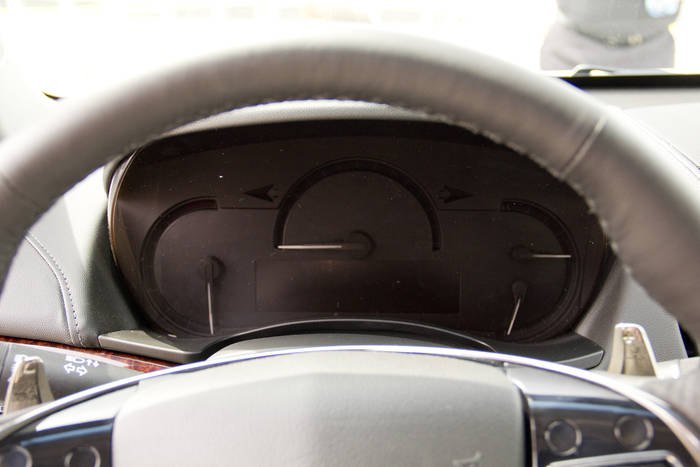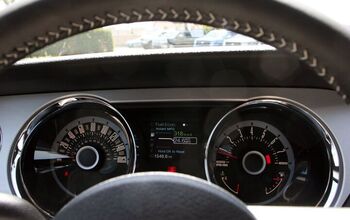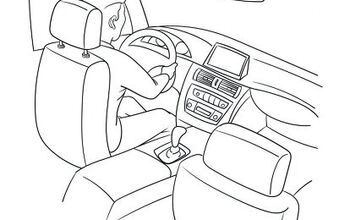Vellum Venom Vignette: ATS Cluster Commotion?

Fellow TTAC scribe Alex Dykes put a somewhat innocent enough post on our Facebook Wall, suggesting the BMW 3-series has a reputation for homogenous design, while the new Cadillac ATS suffers from…well, what so many modern GM products suffer from: a new release that’s only “almost” there. The ATS gauge cluster was his proof.
This cluster spurred a commotion from our FB readers that merited a chat window popping up from the Esteemed Mr. Dykes, suggesting this is a good Vellum Venom. Agreed.
The ATS’ cluster, much like a 94-96 Impala SS’ body in midnight black, is fine at night. The two half circles at each side with the speedo resting atop a multifunction display like a side view of eggs sunny-side up is different: and that’s not a bad idea in a sea of straightforward circles from BMW and Mercedes. A previous foray into this territory by Detroit, the Lincoln LS, was horribly boring and bland.
So let’s wait ’till dawn, shall we?
Oh dear. This is just far too much like the charcoal Tupperware designed Pontiacs of yesteryear. While the Cadillac SRX’s jeweled signal lights are cool and ballsy like tail fins on a DeVille, the ATS has…beveled black plastic accented lights. And that’s the nicest part of the whole cluster.
The flat plane gauge housing, draped in a dull wall of flat black, with cheap needles (again, see the SRX cluster) is so decidedly downmarket that the Kia Optima wouldn’t have it. The multifunction screen’s shape, size and location makes it poorly integrated into the circular theme. And heck, even my Ford Ranger doesn’t have those bizarre indentations for the idiot lights. Where did it all go wrong?
Honestly I don’t know…but the last Buick LeSabre (2005) was probably a low point for GM gauge design. The lumpy gauge receptacles made of cold/brittle looking (yet surprisingly color keyed!) plastic look more like the cute mushroom-thingies from Super Mario Brothers. It’s purely unrefined, and a lack of refinement is the main problem with the ATS’ cluster.
Compare it to what we saw a few decades ago.
Here’s a 1983 LeSabre dash. Note how the warm and inviting looking (if fake) wood trim surrounds the round gauges in a non-mushroom like fashion. There’s also a nice chrome ring frenched in for a decidely upscale look, even with the famous Malaise-era plastic quality. The last rear wheel drive LeSabre, Electra, Park Avenues from the early 1980s had a very upscale quality about them.
It was like a traditional Cadillac, but cleaner and far less ostentatious. It, chassis dynamics aside, was a proto ATS in this regard. I can’t believe I just said that. But here we are.
Perhaps the next photo is better ATS historical reference fodder.
I wish I grew up with the first-gen Pontiac Grand Prix. Reading the history and seeing them at car shows leads a youngblood to think these GM products were the high point of entry level luxury for Detroit.
No, for the world.
A fantastic car? Probably. A fantastic gauge cluster with real walnut trim and timeless mid-century design in the chrome gauge bezels? Wow, that’s the stuff right there, son.

More by Sajeev Mehta
Latest Car Reviews
Read moreLatest Product Reviews
Read moreRecent Comments
- Slavuta Autonomous cars can be used by terrorists.
- W Conrad I'm not afraid of them, but they aren't needed for everyone or everywhere. Long haul and highway driving sure, but in the city, nope.
- Jalop1991 In a manner similar to PHEV being the correct answer, I declare RPVs to be the correct answer here.We're doing it with certain aircraft; why not with cars on the ground, using hardware and tools like Telsa's "FSD" or GM's "SuperCruise" as the base?Take the local Uber driver out of the car, and put him in a professional centralized environment from where he drives me around. The system and the individual car can have awareness as well as gates, but he's responsible for the driving.Put the tech into my car, and let me buy it as needed. I need someone else to drive me home; hit the button and voila, I've hired a driver for the moment. I don't want to drive 11 hours to my vacation spot; hire the remote pilot for that. When I get there, I have my car and he's still at his normal location, piloting cars for other people.The system would allow for driver rest period, like what's required for truckers, so I might end up with multiple people driving me to the coast. I don't care. And they don't have to be physically with me, therefore they can be way cheaper.Charge taxi-type per-mile rates. For long drives, offer per-trip rates. Offer subscriptions, including miles/hours. Whatever.(And for grins, dress the remote pilots all as Johnnie.)Start this out with big rigs. Take the trucker away from the long haul driving, and let him be there for emergencies and the short haul parts of the trip.And in a manner similar to PHEVs being discredited, I fully expect to be razzed for this brilliant idea (not unlike how Alan Kay wasn't recognized until many many years later for his Dynabook vision).
- B-BodyBuick84 Not afraid of AV's as I highly doubt they will ever be %100 viable for our roads. Stop-and-go downtown city or rush hour highway traffic? I can see that, but otherwise there's simply too many variables. Bad weather conditions, faded road lines or markings, reflective surfaces with glare, etc. There's also the issue of cultural norms. About a decade ago there was actually an online test called 'The Morality Machine' one could do online where you were in control of an AV and choose what action to take when a crash was inevitable. I think something like 2.5 million people across the world participated? For example, do you hit and most likely kill the elderly couple strolling across the crosswalk or crash the vehicle into a cement barrier and almost certainly cause the death of the vehicle occupants? What if it's a parent and child? In N. America 98% of people choose to hit the elderly couple and save themselves while in Asia, the exact opposite happened where 98% choose to hit the parent and child. Why? Cultural differences. Asia puts a lot of emphasis on respecting their elderly while N. America has a culture of 'save/ protect the children'. Are these AV's going to respect that culture? Is a VW Jetta or Buick Envision AV going to have different programming depending on whether it's sold in Canada or Taiwan? how's that going to effect legislation and legal battles when a crash inevitibly does happen? These are the true barriers to mass AV adoption, and in the 10 years since that test came out, there has been zero answers or progress on this matter. So no, I'm not afraid of AV's simply because with the exception of a few specific situations, most avenues are going to prove to be a dead-end for automakers.
- Mike Bradley Autonomous cars were developed in Silicon Valley. For new products there, the standard business plan is to put a barely-functioning product on the market right away and wait for the early-adopter customers to find the flaws. That's exactly what's happened. Detroit's plan is pretty much the opposite, but Detroit isn't developing this product. That's why dealers, for instance, haven't been trained in the cars.







































Comments
Join the conversation
Ugh, seeing that pic of the gauges from the last LeSabre dredges up bad memories. I worked at a Buick dealer during those years. The Buick interiors of the 90's were so cheap as to be shameful. You know that the actual gauge was just a hole cut in the blue plastic with a piece of cardboard behind it, printed with the numbers? And they also had radios with the LCD numbers about an inch high, so old geezers could see them better. Buick was absolute garbage until about 2009.
We're all car guys here, so I suppose some of us fixate on certain nit-picks. I've owned a number of new cars over the last few years. Each one has revealed an engineering or design feature that struck a negative chord. Having taken delivery of a new ATS 3.6L, just four days ago...I think the gauges (as well as all interior design / detailing) is superb. But, the ATS can't be everybody's everything.